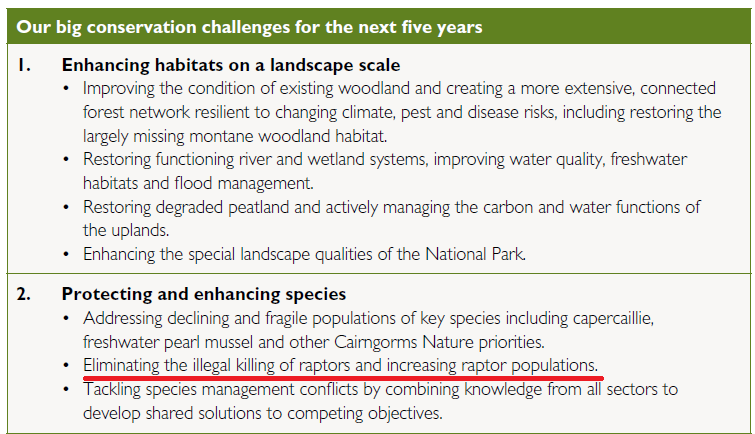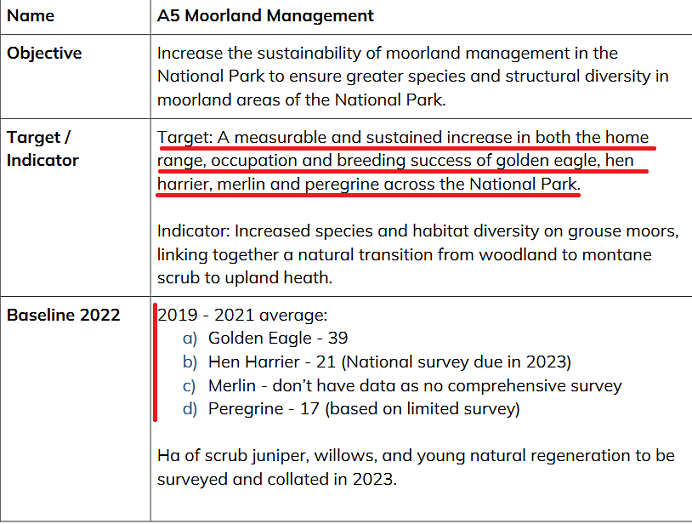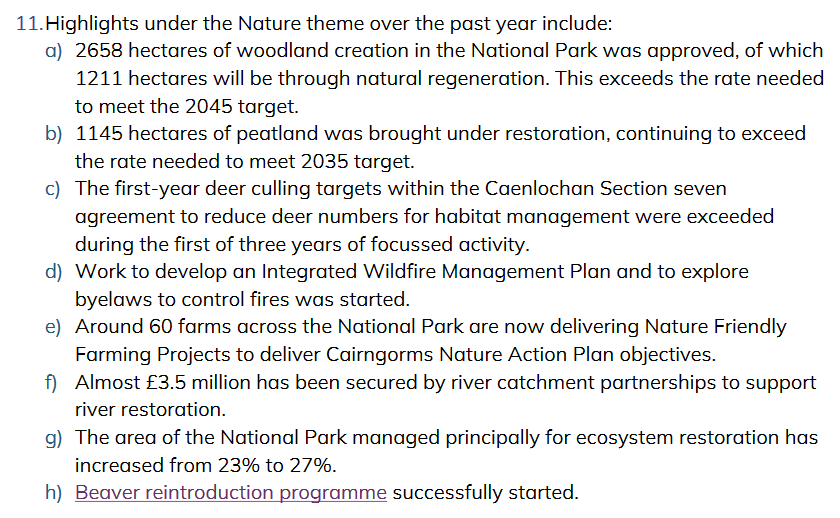Yesterday Raptor Persecution UK reported that a peregrine had been found shot in Glen Esk, around Tarfside (see here). This follows the osprey that a gamekeeper found shot on the inglorious 12th of August in nearby Glen Doll (see here). Both locations are in the northern part of the Angus Glens and lie within the Cairngorms National Park.
There was a time when the Cairngorms National Park Authority (CNPA) issued news releases criticising the unlawful persecution of raptors after such incidents (see hereand here for example) but the last I can find is from May 2021. Since then the CNPA has issued two news releases announcing “breeding success” for raptors in the East Cairngorms Moorland partnership area, its project to try and improve intensive grouse moor management. The first, in July 2021 (see here), stated a pair of sea eagles had bred at Balmoral. The second, in March this year (see here), reported that 3 out of 12 pairs of golden eagle, 8 out of 9 pairs of peregrine and 8 out of 11 pairs of hen harrier had bred chicks in 2023.
The second news release made no attempt to put this “breeding success” in perspective. Why, for example, were there only 12 pairs of golden eagle in the east Cairngorms Moorland Partnership Area, which comprises about a quarter of the National Park, when the Isle of Harris, where the land is far less productive, supports 20 pairs? Nor did the news release explain why all of the 11 pairs of hen harrier recorded were found on the Mar Lodge Estate and none, apparently, on the other estates still in the partnership, Balmoral, Delnadamph (also owned by King Charles), Glen Livet, Glen Avon and Mar (Invercauld was ejected from the partnership because of raptor persecution in 2021 (see here)).
Unless the CNPA can prove otherwise, it appears to me the most likely explanation for the variations in breeding density and distribution of raptors within the east Cairngorms Moorlands Partnership area is that raptor persecution, particularly of the species which prey on red grouse, is continuing there but undetected. What is certain, however, is that raptors that do breed successfully on the estates within the partnership are at very high risk if they disperse after breeding to the Angus Glens; the disappearance of the satellite tagged hen harrier Shalimar in March provides just one example (see here). Unfortunately, the CNPA has retreated from tackling the problem head on and is failing to report what is really happening.
In its previous National Park Partnership Plan, for the period 2017-22 (when it was still issuing news releases about raptor persecution) the CNPA was committed to “Eliminating the illegal killing of raptors and increasing raptor populations”:

Having failed to deliver on this challenge, instead of analysing the reasons why and developing a detailed plan to tackle the issues, the CNPA watered down their aspirations and targets for the current the new NPPP for 2022-27. Their current commitment in respect of raptors is summarised in the annual update report on the NPPP which CNPA staff gave to their board on 13th September (for the two papers see here):

Since most raptor persecution incidents never come to light – that depends mainly on birds being satellite tagged but also accidental finds by walkers – it does make sense to measure not just the number of raptors, as per the previous NPPP, but also their range and breeding success. However, abandoning the elimination of raptor persecution as a target was a major step backwards given the long history of such persecution in the Cairngorms.
Moreover, focusing attention on just four species – golden eagle, hen harrier, merlin and peregrine – when the CNPA records that 18 species of raptor and owl occur in the National Park (see here), is blinkered and serves to cover up the extent to which all species are affected by persecution. The recently shot osprey, a species which the CNPA describes (in the link above) as a “conservation success story” provides a case in point.
The Board Paper (see here) accompanying the NPPP update report only mentions successes, not failures across all three themes in the plan, people, place and nature:

This report marks a new low in terms of spin by the CNPA. For example there is absolutely no reference to the disastrous planting projects at Kinrara (see here) Far Ralia (see here) or Muckrach (see here) which have released carbon into the environment and destroyed nature. But for the purposes of this post the key point is there is absolutely no mention of raptors. Forget raptors, having made not a jot of difference, the CNPA has moved on to beavers:
“There’s been projects to conserve and enhance all manner of rare and special species including aspen, wildcats, waders, raptors, twinflower, pine hoverfly – and now we’re looking at the return of beavers after an absence of 400 years.” (Grant Moir, Chief Executive, on the “achievements” of the National Park on its 20th anniversary (see here)).
Just don’t expect the beaver translocation programme to move on to the eastern half of the National Park dominated by intensive grouse moor management!
The data on raptors underpinning the actual NPPP update report appears unfit for purpose:

A year and a half later, the CNPA still cannot present data on raptors, persecution incidents and an “assessment of project progress” for 2022-23. While stating this will follow, the report does not say when. Whether the “project” referred to is the three year Cairngorms Raptor Project or Raptor Track is unclear. Even for the East Cairngorms Moorland Partnership, where the CNPA is focussing on just four species “data collection is not entirely comprehensive for all species”. Actually, if data is missing for merlin and peregrine, that means its missing for half the species the CNPA is trying to monitor! As for the three quarters of the land in the National Park that lies outwith the East Cairngorms Moorland Partnership Area and the other 14 species of raptor and owl that occur, who knows?
The Update Report does, however, contain data from Police Scotland about the number of raptor persecution incidents they have recorded:six were “reported in 2013/24” (sic). While this is likely to be the tip of the iceberg, without any comparison to the numbers reported in previous years, it is not possible for board members, Scottish Ministers or the public to tell whether any progress has made in reducing raptor persecution in the National Park. Perhaps Raptor Persecution UK, which has plotted incidents across the National Park, will address the reporting deficit?
Under progress for 2023/24 the Update Report states that the Wildlife Management and Muirburn Act became law in the summer and the “effectiveness of the Act will be partly assessed through monitoring of raptor populations”. The CNPA which should have been at the forefront in helping to monitor the Act appears, from the report, to be in no position to do so. Why not?
For all the gaps, the report does contain one interesting piece of information about the likely impact of the new Act:

My reading of the Act is that while grouse moor licenses can be revoked as a result of raptor persecution, NatureScot cannot refuse to issue them on the basis of incidents which took place prior to any application for a license. If that is right, it appears that some grouse moor owners may already be gaming the new system. In that respect it would be helpful if the CNPA now started to map raptor persecution incidents against which grouse moors in the National Park hold or have applied for a grouse moor license.
As I argued in July (see here) after a goshawk nest on the Pitmain Estate was subject to a shotgun attack, unless and until the CNPA starts to address the reasons why raptor persecution takes place nothing is likely to change. The public should be expecting far more from Scotland’s National Parks.

The CNPA had promised that state of the art satellite tags would be fitted to raptors in the Park. No such tags were ever fitted. For a couple of years barely a handful of eagles were fitted with standard tags but this token response soon petered out & no other raptor species were tagged. Therefore the likes of heavily persecuted species such as harriers, goshawks & kites were never tagged. To all intents and purposes the Park authority have be trying to divert attention away from the continued persecution, with schemes for beavers & cranes. Sweeping crime under the carpet will only serve to perpetuate it. It’s time the CNPA dealt with these despicable crimes, which portray Scotlands Cairngorm National Park as a joke.